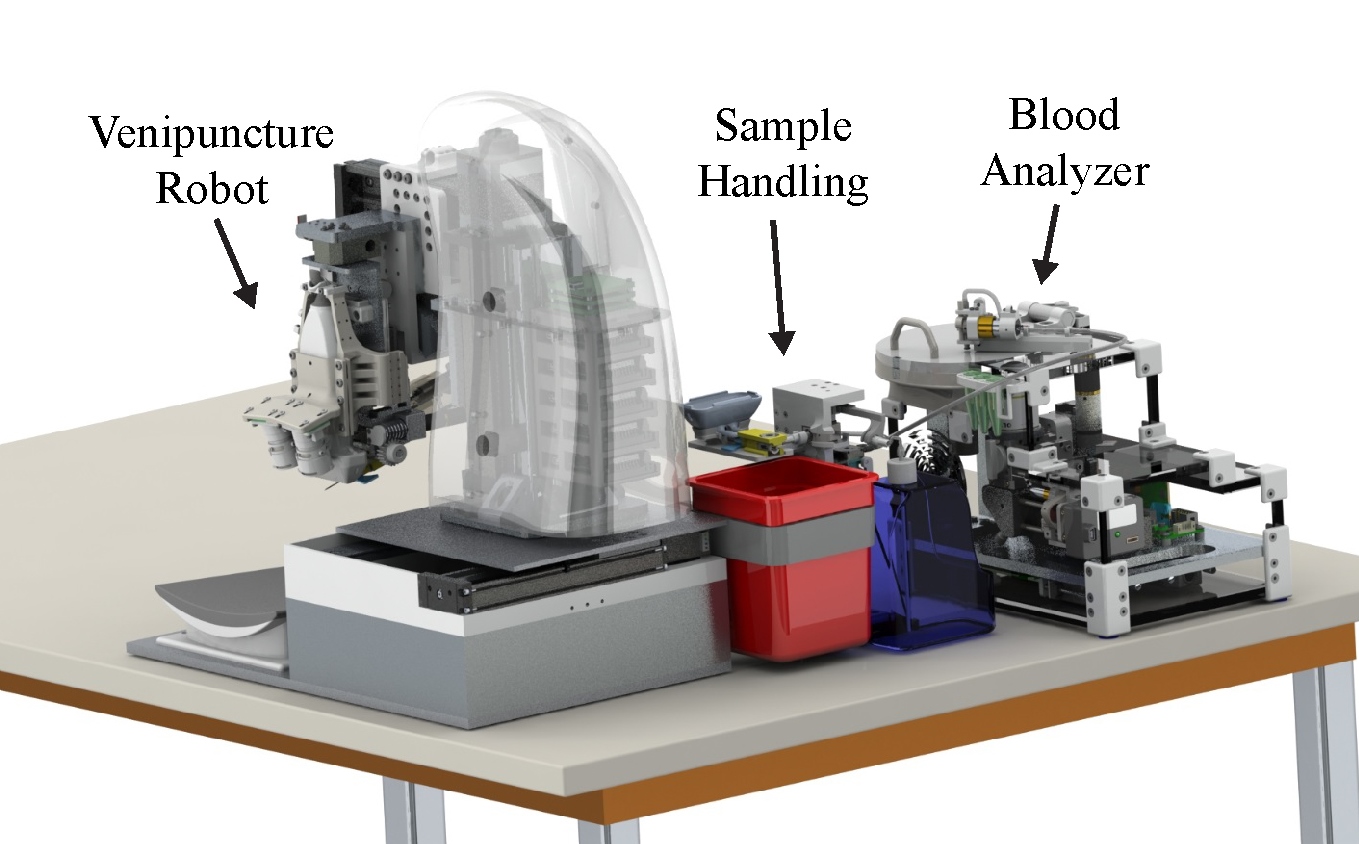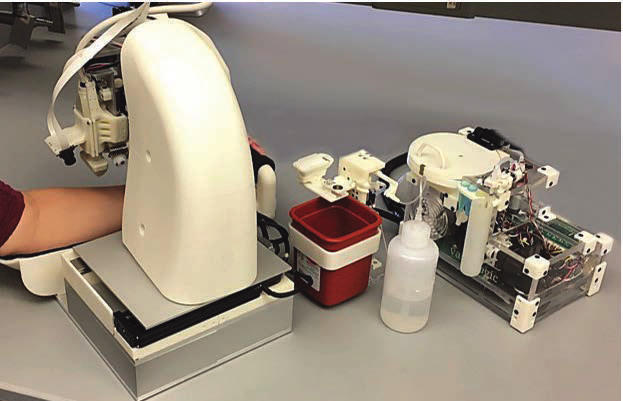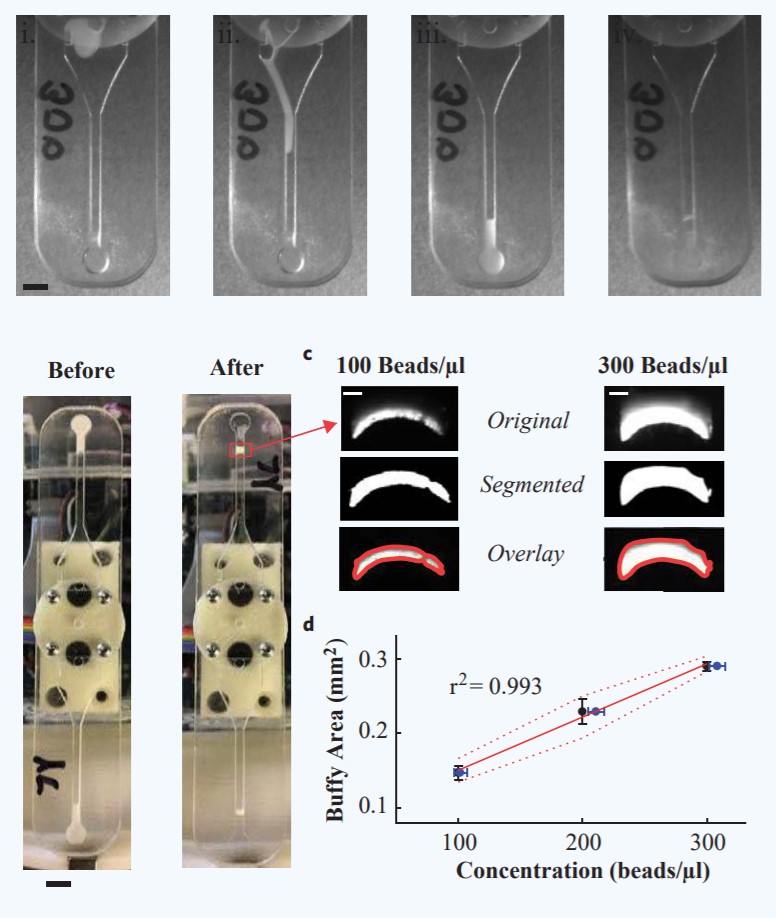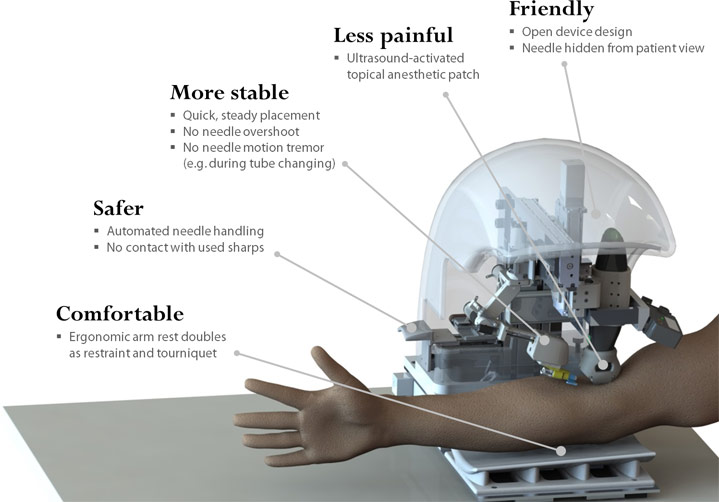Robotic system speeds up blood collection and testing
A team of scientists from Rutgers University has created a fully automated system designed to simplify the collection of venous blood and testing in medical institutions. The main components are a blood sampling device, a sample collection module and a centrifuge with “laboratories on a chip”. At the moment, the device can perform differential leukocyte counting and measure hemoglobin levels.

Blood tests are the most common clinical procedure in the world. In the United States, 2 billion such procedures are carried out every year, and their results affect 80% of medical decisions made in hospitals and laboratories. The quality of the procedure depends on the skills of the specialist and on the physiological characteristics of the patient. Often problems arise when taking blood in children and in obese people - they have difficulty finding veins. Most of the research is carried out centrally: from individual clinics materials are sent to specialized laboratories. In the work of many laboratory technicians, after which the results should be communicated to patients. From the point of view of logistics, this is a complicated and expensive scheme.
A team of biomedical engineers from Rutgers University has developed a device to solve problems with the complexity of logistics, the quality of material collection and the speed of analysis - Point of care testing (POCT). The robotic system takes blood, the sample enters the microfluidic system - “lab-on-a-chip”, the centrifuge separates the blood into components, and the optical microscope determines the number of leukocytes. The device can be installed in a hospital bed or in an ambulance or doctor’s office.
At the first stage, the apparatus for blood collection is included. The device receives data using ultrasound (ultrasound) and spectroscopy in the near infrared region (NIR spectroscopy), the software makes a three-dimensional map of the veins, after which a miniature manipulator with a needle puncture and take blood.

The function of the next module is to transfer a blood sample to a “lab on a chip”, which will then be in a centrifuge for analysis. Scientists used a peristaltic pump, which delivers the sample, and washing the apparatus with saline. Venupuncture robot makes a puncture, the pump turns on and sends the material to the next module.

The analyzer consists of an acrylic chip containing a sample, a centrifuge for blood fractionation and an optical microscopic system. The centrifuge rotates the acrylic chip at a speed of 10,000 rpm to separate the cellular components of blood from the plasma inside the chip. The disposable chip is made of three layers of acrylic: external 1.5 mm and internal 0.9 mm. A channel is cut out in the chip, along which the components of the sample in the desired sequence align the centrifugal force. A tiny fluorescent microscope, after detecting white blood cells - leukocytes - measures the thickness of their layer and compares it with the help of the software developed by the team with the preset settings.

“The device is a dream of developing blood test technologies. The integration of miniature robotic and microfluidic systems allowed us to combine the accuracy of traditional analysis technologies with the speed and convenience of carrying out procedures anywhere and at any time, ”the study authors enthusiastically comment on their development.
Scientific work published in the journal Technology. doi.org/10.1142/S2339547818500048
Robots capable of taking human blood from a vein have already been done. For example, the startup Veebot in 2013 introduced a similar device. The patient places the arm in the cuff, the infrared camera searches for the veins, and the ultrasound determines if there is sufficiently intense blood in the vein. Then the robotic arm takes the blood. The device finds a vein with an accuracy of 83%. The procedure lasts a minute. At the moment, nothing has been heard about the project since about 2013, but the site indicates that the company is recruiting employees.
Another startup with a similar technology is VascuLogic. The VenousPro device uses the same sensors to make blood sampling as quick and painless as possible for humans.


Blood tests are the most common clinical procedure in the world. In the United States, 2 billion such procedures are carried out every year, and their results affect 80% of medical decisions made in hospitals and laboratories. The quality of the procedure depends on the skills of the specialist and on the physiological characteristics of the patient. Often problems arise when taking blood in children and in obese people - they have difficulty finding veins. Most of the research is carried out centrally: from individual clinics materials are sent to specialized laboratories. In the work of many laboratory technicians, after which the results should be communicated to patients. From the point of view of logistics, this is a complicated and expensive scheme.
A team of biomedical engineers from Rutgers University has developed a device to solve problems with the complexity of logistics, the quality of material collection and the speed of analysis - Point of care testing (POCT). The robotic system takes blood, the sample enters the microfluidic system - “lab-on-a-chip”, the centrifuge separates the blood into components, and the optical microscope determines the number of leukocytes. The device can be installed in a hospital bed or in an ambulance or doctor’s office.
At the first stage, the apparatus for blood collection is included. The device receives data using ultrasound (ultrasound) and spectroscopy in the near infrared region (NIR spectroscopy), the software makes a three-dimensional map of the veins, after which a miniature manipulator with a needle puncture and take blood.

The function of the next module is to transfer a blood sample to a “lab on a chip”, which will then be in a centrifuge for analysis. Scientists used a peristaltic pump, which delivers the sample, and washing the apparatus with saline. Venupuncture robot makes a puncture, the pump turns on and sends the material to the next module.

The analyzer consists of an acrylic chip containing a sample, a centrifuge for blood fractionation and an optical microscopic system. The centrifuge rotates the acrylic chip at a speed of 10,000 rpm to separate the cellular components of blood from the plasma inside the chip. The disposable chip is made of three layers of acrylic: external 1.5 mm and internal 0.9 mm. A channel is cut out in the chip, along which the components of the sample in the desired sequence align the centrifugal force. A tiny fluorescent microscope, after detecting white blood cells - leukocytes - measures the thickness of their layer and compares it with the help of the software developed by the team with the preset settings.

“The device is a dream of developing blood test technologies. The integration of miniature robotic and microfluidic systems allowed us to combine the accuracy of traditional analysis technologies with the speed and convenience of carrying out procedures anywhere and at any time, ”the study authors enthusiastically comment on their development.
Scientific work published in the journal Technology. doi.org/10.1142/S2339547818500048
Robots capable of taking human blood from a vein have already been done. For example, the startup Veebot in 2013 introduced a similar device. The patient places the arm in the cuff, the infrared camera searches for the veins, and the ultrasound determines if there is sufficiently intense blood in the vein. Then the robotic arm takes the blood. The device finds a vein with an accuracy of 83%. The procedure lasts a minute. At the moment, nothing has been heard about the project since about 2013, but the site indicates that the company is recruiting employees.
Another startup with a similar technology is VascuLogic. The VenousPro device uses the same sensors to make blood sampling as quick and painless as possible for humans.

Only registered users can participate in the survey. Sign in , please.
